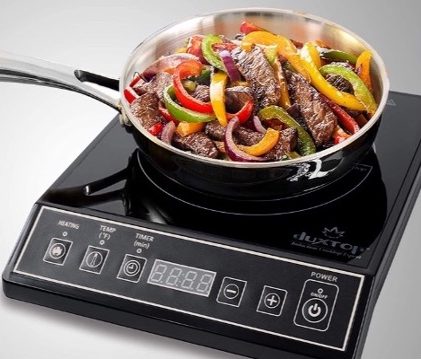Induction Cooking
Lower your carbon footprint, and enjoy a healthier and safer kitchen

Four Reasons to Switch
For Your Planet: Lower your greenhouse gas emissions by cooking with electricity rather than gas or propane. Induction cooking requires less energy than cooking with gas or with conventional resistance electric cooking.
For Your Health: Cooking with gas pollutes the air in your home, even when the stove is not in use. Eliminate toxic emissions that can lead to asthma and cardiovascular disease.
For Your Cooking Experience: Induction offers faster heating, quicker response time and more precise heat control at all temperatures. The flat surface makes cleanup easy and offers beautiful kitchen design options.
For Your Safety: Improve the air quality in your home and eliminate the risk of gas leaks. Greatly reduce the risk of fire and burns.
Give induction cooking a try. Single burner portable units are inexpensive and can be plugged into a regular outlet.
More Information
Long the mystery technology of the home kitchen, induction cooking appears poised to finally have its mainstream moment. Compared to the traditional cooktop technologies of electric resistance coil and gas flame, induction cooking is superior in almost every way. The Massachusetts Clean Energy Center offers a good introduction:
goclean.masscec.com/clean-energy-solutions/induction-cooking/
As with electric vehicles, switching to an induction cooktop may seem like a great leap, trading familiar comforts for the unknown. A host of misconceptions have slowed its adoption by American cooks. Let’s take a deeper look at what induction cooktops are – and are not.
Technology of induction – Induction cooking uses a magnetic field to directly heat a pan, rather than heating a surface or adjacent air which in turn heats the pan. This short video provides a nice and concise overview:
www.finecooking.com/article/how-an-induction-cooktop-works
Benefits
Carbon footprint and air quality –There are no gas fumes to exhaust, and you’re not flaring off fossil fuels from your kitchen. This is where the carbon footprint magic happens. Induction is a sort of heat pump or electric vehicle for your kitchen. Eliminating open gas flames also brings a breath of fresh air to your kitchen – inhale the savory aromas without the gas exhaust. Note you’ll still want an exhaust vent to draw off any smoke or steam from the cooking process.
Efficiency – various studies have shown induction to be significantly more energy efficient than gas cooking. Induction technology imparts as much as 90% of energy into the food you are heating. The figure is below 40% for gas, as flames must first heat the intermediate air layer below the pan and in turn the pan itself. This process also allows for significant efficiency loss as heat radiates sideways out beneath the pan, warming your kitchen rather than the food.
Speed – induction cooking is quicker than gas, both to your initial target and also in response to any adjustments you make. When your recipe says “bring to a boil, then reduce to a simmer”, all that happens in as little as half the time with induction versus gas. Old school electric coil ranges are too slow to even be in this conversation.
Physical safety – Contrary to some claims, the glass directly below the pan will get hot. However, the surrounding glass remains cool to the touch. Moreover, the heating element area cools almost immediately once the pan is removed. This is a big safety feature in a home with curious toddlers, or distracted cooks! The cooktop will also shut itself off once pans are removed and the magnetic connection is disrupted. There is no wondering “did I turn that burner off?”
Cleanup – Dinner is not complete until the kitchen is clean, and induction cooktops really shine at this point. A gas range needs to cool, then have individual grates and burners scrubbed clean. In contrast, the induction cooktop can be wiped off with a damp sponge, sprayed with a glass cleaner, then polished streak-free with a soft cloth. That’s it! The entire process takes less time than loading the dishwasher.
What it’s Not
Not Slow – Forget those memories of the old electric coil cooktops. Even compared to gas, the difference is pronounced. It is most noticeable with larger jobs, such as a stockpot filled with water for pasta, where induction may generate a boil in a little as half the time as gas.
No “special” pans – This is a common misconception. While some pans will not work with induction cooktops, most are fine. If a household magnet sticks to a pan, that pan will work. You won’t find yourself shopping online for special “Induction Pan Sets”. Most stainless steel and all cast iron pans, whether vintage black skillets or enameled pots such as Le Creuset, work perfectly. If shopping for pans, just check the icons on the bottom. Even many lower-priced pans now carry the induction-ready stamp. Aluminum will not work, nor will copper or copper-bottom pans. There may be some buzzing noise from lighter pans or those with minimal iron content.
Not traditional looking – This design factor that has undoubtedly slowed the adoption of induction cooktops and ranges in American kitchens. Rugged grates on commercial-style gas ranges conjure “the look of cooking.” In contrast, sleek induction cooktops look more like a giant iPad or TV screen on the kitchen counter. This seems likely to be a slow but ongoing change, as kitchen designers become more familiar and comfortable with induction, and consumer acceptance and style preferences evolve.
Not a dangerous source of radiation. Induction cooktops do generate an electromagnetic field, as does any appliance when electricity is in use. Despite some fearful internet claims, however, this is a low level and safe for human interaction. Induction cooktops meet all federal regulations and consumer safety standards for emitted electromagnetic fields. Note that one caution should be considered by users with pacemakers or similar implanted cardio devices. Appliance manufacturers do recommend such users consult their physician to ensure induction is a safe choice for them.
Notes and Cautions
Glass top – The ceramic glass surfaces of induction cooktops are very tough, but are not indestructible like the grates on a gas range. Just be careful with the vintage cast iron!
Cost considerations – Costs are coming down and choices are expanding from more manufacturers. Still, induction appliances remain comparatively expensive versus older technologies. Few options exist below $1,000, and those tend to be smaller units. In late 2021, larger 30” and 36” units with 4 or 5 heating elements start at about $1,500 and may cost twice that much for premier brands.
Update, Replace or Renovate – Given the cost considerations, few homeowners would pull out a well-functioning gas or electric range to update to an induction appliance. However, if that old range is on its last legs, or has failed entirely, replacement with induction is a sensible option. Doing your homework in advance helps make a confident choice on short notice. Finally, if a new kitchen is in your future, engage early with your designer to incorporate induction into the plans.


